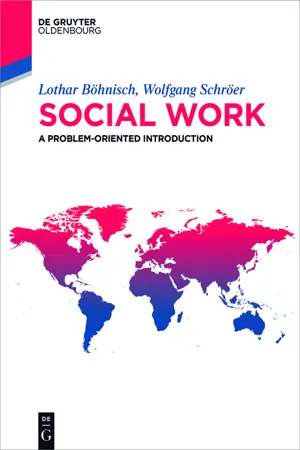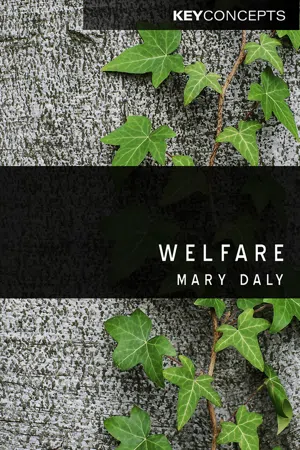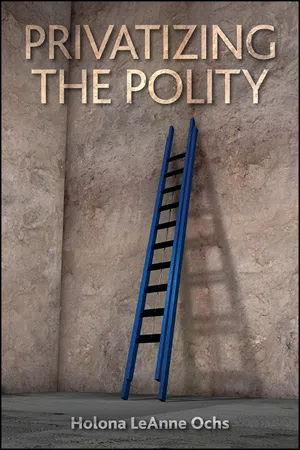Social Sciences
Welfare Policy
Welfare policy refers to the government's approach to providing social assistance and support to individuals and families in need. It encompasses a range of programs and initiatives aimed at promoting the well-being and economic security of citizens, such as unemployment benefits, healthcare coverage, and food assistance. Welfare policies are designed to address poverty, inequality, and social welfare concerns within a society.
Written by Perlego with AI-assistance
Related key terms
Related key terms
1 of 4
Related key terms
1 of 3
7 Key excerpts on "Welfare Policy"
- eBook - ePub
- Lothar Böhnisch, Wolfgang Schröer(Authors)
- 2016(Publication Date)
- De Gruyter Oldenbourg(Publisher)
10Social Work and Welfare PolicySocial work and Welfare Policy are closely interlinked. In this context, social work is seen as a living inventory of social policy. While social policy relates to social protection against standardized risks such as illness, unemployment and poverty, social work deals with the various biographical results and side effects of these risks, as well as individuals’ other psychosocial problems. Until now, the welfare state has been the central institution for the social policy of most European countries. However, an examination only of state activities and the responsibilities they directly and indirectly delegate to municipalities and associations is not enough to gain a picture of social work’s true socio-political environment. Looking merely at civil society activities or the social services and nursing market, which complements the state sector while also being privately operated, there is talk of a “welfare mix” where social work needs to find and form networks, mainly within the region and the municipality.Here, social work complies with the terminological distinction made by Franz-Xaver Kaufmann (2003), who sees socio-political tasks as including not only the legal and economic field of social policy (legal equality, transitional employment services, the equalization of burdens and social spending) but also the field of social infrastructure development (including social work services) and pedagogical intervention.The welfare state has developed within the boundaries of each nation state. Over the process of globalization, these borders have started to crumble; national welfare states have lost their power to shape the system. This has also affected the opportunities and limits of social work, as an agency belonging to the welfare state. For this reason it needs to rethink its Welfare Policy; it requires socio-political reflexivity - The model of citizenship that prevails in a country or is argued for is closely related to the type of welfare state that exists or is sought. The term ‘welfare state’, which is the subject of chapter 4, connotes a particular form of the state, one oriented to meeting needs and addressing a range of welfare-related exigencies. In this state form, government takes responsibility for those unable to provide for their own welfare and, depending on how widely the notion of public welfare (or social citizenship) extends, guarantees not just support but security in a range of eventualities. The welfare state constitutes, therefore, a very different approach to the Poor Law, with its focus on meeting the worst cases of need only and its tests of deservingness. Marshall’s (1950) threefold classification of citizenship captures much about the welfare state and its variations: the more expansive are social rights the more developed is the welfare state. Political science treats the welfare state as a structure of power especially, both an outcome of political processes and in turn effecting political intervention. It does not just happen therefore but, as we shall see, is fought for and remains contested.The Social Meanings of WelfareThe idea of social welfare provides a further counterpoint again to those depictions of welfare discussed to date. As developed in the disciplines of Social Policy2 and social work, and sociology to a lesser extent, considerations of social welfare are more complex than could be imagined from a neo-classical economics perspective. If economists work with preferences as a proxy for welfare, social scientists tend to focus on needs and social problems and responses to both. The concept of need is seen to describe something about human nature that is more essential than the economists’ ‘preferences’ (Fitzpatrick 2001: 7). It is also a less individualistic concept. Welfare in a social vein is intimately connected, then, with societal ends and functioning, especially in terms of the measures to be taken to address such phenomena as poverty, unemployment, ill-health, social inequality. The social disciplines share considerable common ground with philosophy and political science. Indeed, many of the debates in political philosophy were also rehearsed from a social perspective. But they tended to be fractured through three lenses:
- views about the nature of the human condition and how it can be improved;
- investigations of the nature and origins of social problems and how they are connected to social organisation and the (mal)distribution of resources;
- convictions about the implications and effectiveness of different approaches to social intervention and reform and how they sit with prevailing norms and ideologies.
In the early days especially, social criticism – of prevailing conditions and the functioning of different forms of policy and collective response in light of need – was central. This early work ‘fixed’ welfare in a particular frame: social problem solving.3 - eBook - ePub
- Holona LeAnne Ochs(Author)
- 2015(Publication Date)
- SUNY Press(Publisher)
1Framing the Welfare Policy Process
Public policy is concerned with problem definition, issue construction, agenda setting, the emergence of policy options, the actions (or inactions) of governance, and the effects and impact of such action or inaction. Welfare Policy articulates values, crafts meaning, justifies political decisions, assigns or reinforces status, and may even attempt to solve social problems. The boundaries of the welfare conflict space are defined by the understandings generated through the battles over problem definition, the political negotiations over policy design and adoption, the bargaining, competition, and cooperation inherent in the implementation, and the culture and craft of enactment. The potential for learning from these conflicts is contingent upon the type of evaluation or analysis as well as the degree of opportunism.This chapter proceeds by outlining the research defining the nature of those boundaries and the interconnected processes of welfare provision. Then, I describe a theoretical framework for analyzing the impact of Welfare Policy that offers the potential for learning. Understanding the extent to which different policy choices provide opportunities for large numbers of people to move out of poverty by comparing how programs vary across states is a necessary but not sufficient condition for policy learning. It is essential that we also consider the nature and location of influence in order to ascertain for whom opportunities are afforded. My approach utilizes various analytical strategies to identify how opportunities can be broadly obtained and opportunism minimized. In this chapter, I also explain those analytic strategies.Organizing the Welfare Literature throughout the Policy Process
Welfare Policy as a field of study began with the definition of poverty as a social problem. Stories of welfare practices in the United States cannot be easily untangled from the Judeo-Christian traditions that defined the worldviews of the colonists and shaped the approach that the colonies took toward the welfare of the native populations. In many respects, those stories emphasize compassion, but the practices reveal patterns of compassion for those deemed worthy. In the European Christian worldview, God’s will was invoked to enrich and empower Christian followers. Consequently, Native Americans represented an opportunity to convert more souls and justify the taking of native lands in the name of God and the monarchy. Alternatively, the concepts of reciprocity and the practice of gift exchange were the central tenets of building relationships, forming alliances, addressing disparate needs, and established the welfare customs of the North American Indians. Reciprocity and gift exchange are based on the behavior of the “other” and maintain an emphasis on long-term objectives. These practices represent fundamental differences in the worldviews of the colonists and the indigenous population regarding human welfare. Attempts to enslave Native North Americans were unsuccessful, so contracts for indentured servitude, primarily performed by African slaves, convicts, paupers, and servants from the British Isles and throughout the continent of Europe, were sanctioned by colonial authorities. The contracts often provided the prospect of land ownership as an incentive at the end of the period of service, but the condition of servitude also often required conversion to Christianity and was justified as a charitable act by Christians.1 - eBook - ePub
Social Policy for Effective Practice
A Strengths Approach
- Rosemary Kennedy Chapin, Melinda Lewis(Authors)
- 2020(Publication Date)
- Routledge(Publisher)
Research has identified multiple ways work can contribute to individuals’ well-being, even apart from its contributions to their financial security (McKee-Ryan et al., 2005; Turner & Turner, 2004). Advanced welfare states have long emphasized the connection between public benefits that enable people to be healthy and well-educated and citizens’ obligations to contribute to society. However, these systems also subsidize education and training more heavily than in the United States, particularly at the early childhood and post-secondary levels. Combined with policies such as paid family leave, which balance personal and corporate needs, investments in education and training equip individuals to fulfill labor market obligations in the rapidly changing economy. With this more comprehensive approach, social welfare programs can serve the needs of capitalism as well as of individuals. These kinds of initiatives align with a capacity-building state, which focuses on strengthening the skills and competencies of people and on helping them secure the resources they need for full economic and social inclusion. In addition to prioritizing investment in human capital and social connection, capacity-building states include income support to assist people who face significant structural barriers that trap them in poverty. Social workers need to work alongside affected populations to mobilize resources for investments that will increase opportunities and improve outcomes for groups that have been oppressed. Economic and Political Schools of Thought The United States has a long history of pluralism. In our policymaking process, no one group holds all the power. Instead, many groups are actively involved in creating and implementing public and private policies at the federal, state, and local levels, informed by a variety of philosophies. These strands all contribute to our social welfare system - eBook - ePub
Social Policy for Effective Practice
A Strengths Approach
- Rosemary Kennedy Chapin, Melinda Lewis(Authors)
- 2023(Publication Date)
- Routledge(Publisher)
Kirp, 2011 )—some because these initiatives leverage private financial institutions and may reduce the need for income subsidies, and some because they close gaps in educational attainment. If we can recognize diverse influences and their potential common ground, this understanding can help us craft and enact strengths-based policy that benefits our clients.Particularly in an increasingly globally connected world, examining the development of welfare states in different countries can help us to better understand our own. Esping-Andersen (2002) argues that welfare systems vary substantially depending on the roles the three pillars of welfare—the market, the family, and government—play in providing for basic needs and managing risks. Other scholars have organized nations into different categories by considering delivery of social services, as well as social transfers— predictable cash or in-kind assistance provided to those in or at risk of poverty—and by emphasizing how political forces and gender norms may influence governments’ preferences for welfare approaches (Bambra, 2007 ; Korpi & Palme, 1998 ).Considering the global social welfare landscape, Scandinavian countries have traditionally been examples of countries where citizens rely on the state to provide for basic needs as a right of citizenship. Other countries may rely on a combination of market and family resources, while some use an insurance model, whereby private and government agencies pool contributions to guard against risks. Countries adopt welfare models that grow from particular class relationships and ideological identities. Thus, different countries ascribe different importance to the moral obligation of the government to provide an adequate standard of living. Countries also vary in the extent to which they integrate their welfare systems into their economies, such that public benefits provide adequate protection in times of market failure and promote work when markets expand. Importantly, even some progressives in the United States appear to agree with the conservative argument that high social spending in some European countries damages those nations’ economies, although an advanced welfare state like Denmark now has higher labor market participation and much greater public satisfaction than the United States. As we consider what we can learn from global comparisons, we must recognize that variations in welfare programs reflect the type of society those in power wish to create, how they respond to internal and external pressures, and how they sustain that vision as contexts change. - eBook - ePub
- Norman C. Hunt, W. D. Reekie(Authors)
- 2013(Publication Date)
- Routledge(Publisher)
Policy Analysis and the Welfare StateR. G. S. BROWN SUMMARYThe purpose of this paper is to examine some of the key issues affecting policy development in contemporary British welfare services in the light of recent studies of policy-making. The focus is on the processes through which policy options are taken up and evaluated rather than on the substantive content of the policies themselves. Drawing illustrations from the personal social services, the paper touches on the relevance of institutional arrangements, professional structures, information systems and quantitative techniques for the identification of problems, their exploration, and the implementation of solutions.INTRODUCTION One can distinguish three main aspects of current developments in British social services.First is the recognition and acceptance of community responsibility for meeting additional categories of need. The complacent assumption that the welfare state had relieved all major forms of social need has been swept aside by an accumulation of research, pressure-group activity (often associated with the research) and public concern about social conditions reflected in the mass media. To some extent this disillusionment with the welfare state and its mechanisms followed from the discovery that the institutions established in the 1940s were less effective than had been supposed in reaching out to meet various vulnerable groups – the educationally under-privileged, the disabled, families with low incomes, the inmates of long-stay institutions. Another factor was that conditions such as isolation and sickness in old age, which had been regarded as tolerable and inevitable by an earlier generation, were not so regarded by their successors. In an affluent society, the threshold below which social conditions were categorized as social needs was constantly rising. Moreover, the affluent society itself was creating conditions that seemed to require social action – overcrowding in cities, family breakdowns and stresses caused by greater social mobility, aggravated by the inability of the new neighbourhood communities to cope with deviants and misfits. The cumulative effect has been a demand that the community as an organized whole should accept responsibility for meeting a greater volume of need, at a more adequate standard, in respect of a more widely defined spread of contingencies. - eBook - ePub
Welfare State and Welfare Society
Illusion and Reality
- William Robson(Author)
- 2018(Publication Date)
- Routledge(Publisher)
10Richard Titmuss, in one of his earlier essays, viewed all collectively provided services as designed to meet socially recognised needs, as manifestations of society’s will to survive as an organic whole, and to assist the survival of some people who would go under if left unaided. Needs could therefore be thought of as both individual and social, as interrelated elements essential for the continued existence of the parts and the whole of society.11 In a later analysis he identified in much greater detail the more important aims that underlie the social security system and the social service programmes. These comprise: (1) raising productivity per head, increasing the mobility of workers, and fostering economic growth; (2) safeguarding workers against industrial hazards, and sometimes discriminating in favour of those in the hardest and most dangerous occupations; (3) increasing or decreasing the birthrate; (4) preventing juvenile delinquency, crime and other forms of antisocial behaviour; (5) preventing sickness and ill health in order to increase productivity and the avoidance of suffering; (6) integrating everyone into society to enhance the sense of community and participation, to prevent alienation, and especially to integrate members of minority or ethnic groups and regional cultures; (7) increasing or diminishing inequalities of income and command over resources.12 This complex conception is a far cry from the simple view of the social services as a means of imposing a national minimum standard of life. It is not surprising that Titmuss became increasingly aware of the difficulty of defining a social service in a satisfactory manner in view of the fact that many functions which are not officially included in that category have similar objectives. Thus, while approved schools and remand homes rank as social services, the probation service does not.13 As the scope of state-provided services widen – to include, for example, in Sweden, government loans for furniture and equipment to newly married couples14 or holidays for housewives – it becomes increasingly difficult to go beyond the statement that the social services are characterised by a direct concern with the personal well-being of individuals, and that any form of state intervention which satisfies this criterion is a social service.15
Index pages curate the most relevant extracts from our library of academic textbooks. They’ve been created using an in-house natural language model (NLM), each adding context and meaning to key research topics.
Explore more topic indexes
Explore more topic indexes
1 of 6
Explore more topic indexes
1 of 4






